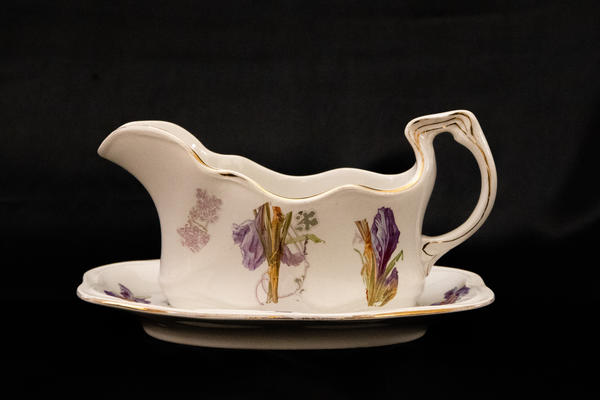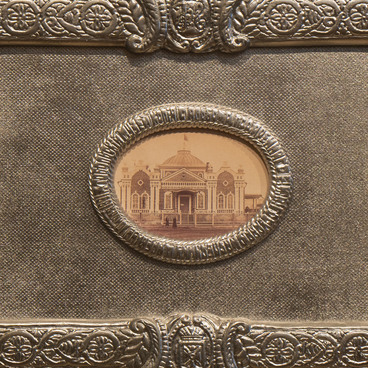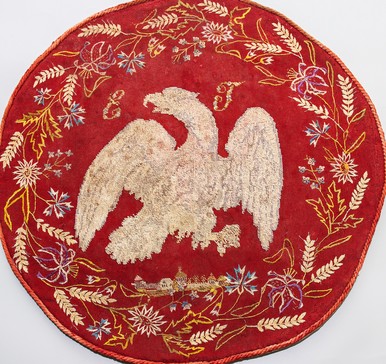The earthenware gravy boat with painting was presented to the Museum of the Romanov family by resident of Tobolsk Larisa Raevskaya. She, in turn, received it from her acquaintance - Irina Pozdnyakova. The old gravy boat belonged to Pozdnyakova’s mother and was passed on to her from her mother-in-law, Maria Loginova. According to researchers, Loginova could serve the Romanov family when they were in Tobolsk exile.
Gravy boat
Время создания
late 19th century — early 20th century
Размер
11.5х21х12.5 cm
Техника
earthenware; glaze, colored glaze, gilding
1
Открыть в приложении#1
Matvey Kuznetsov’s factory
Gravy boat
#2
#3
The gravy boat was part of a large set of tableware from the governor’s house, where the disgraced emperor and his family were housed. The gravy boat also included a small saucer: it has also been preserved to this day, and is presented in the exhibition of the Tobolsk Museum.
#4
The white earthenware gravy boat is painted with colored glaze. Its sides, as well as the saucer boards have images of lilac irises. Parts of the gravy boat are decorated with gilding.
Matvey Kuznetsov founded the Partnership for production of porcelain, earthenware and majolica articles in 1889. He produced tableware and decor items for different categories of buyers: inexpensive practical products with simple decor were designed for peasants, townspeople preferred options with painting similar to sets for noble families. Tableware with exquisite artwork and a gilded inner surface was offered by Kuznetsov to aristocrats.
By the beginning of the 20th century, the Partnership was the largest producer of porcelain and earthenware articles in Europe. It consisted of seven factories, each of which specialized in certain products. The Dulyovo factory produced church utensils, figurines and services painted with large color spots. Single pieces were made in Tver. They included dishes, mugs, bread and caviar bowls. The range of the Budyansk factory included even doll tableware sets.
In 1902, Kuznetsov became the official supplier of the imperial court. His enterprise supplied the Romanov family with tableware till the revolution.
Matvey Kuznetsov’s factories applied a special method of processing clay that then was used to produce earthenware. It was kept for a year in basements with a certain humidity and temperature, after which the material became plastic and did not crack during operation processes. Peat that was extracted no later than in July, was used for roasting. Such fuel had time to dry properly, so it gave an even hot flame and did not produce smoke.
Matvey Kuznetsov founded the Partnership for production of porcelain, earthenware and majolica articles in 1889. He produced tableware and decor items for different categories of buyers: inexpensive practical products with simple decor were designed for peasants, townspeople preferred options with painting similar to sets for noble families. Tableware with exquisite artwork and a gilded inner surface was offered by Kuznetsov to aristocrats.
By the beginning of the 20th century, the Partnership was the largest producer of porcelain and earthenware articles in Europe. It consisted of seven factories, each of which specialized in certain products. The Dulyovo factory produced church utensils, figurines and services painted with large color spots. Single pieces were made in Tver. They included dishes, mugs, bread and caviar bowls. The range of the Budyansk factory included even doll tableware sets.
In 1902, Kuznetsov became the official supplier of the imperial court. His enterprise supplied the Romanov family with tableware till the revolution.
Matvey Kuznetsov’s factories applied a special method of processing clay that then was used to produce earthenware. It was kept for a year in basements with a certain humidity and temperature, after which the material became plastic and did not crack during operation processes. Peat that was extracted no later than in July, was used for roasting. Such fuel had time to dry properly, so it gave an even hot flame and did not produce smoke.
#5
Tobolsk Historical and Architectural Museum — Reserve
читать дальшескрыть
00:00
00:00
1x
Gravy boat
Время создания
late 19th century — early 20th century
Размер
11.5х21х12.5 cm
Техника
earthenware; glaze, colored glaze, gilding
1
Открыть в приложении
Поделиться



